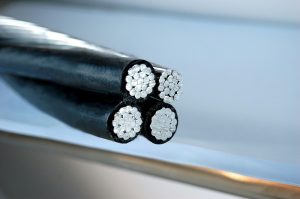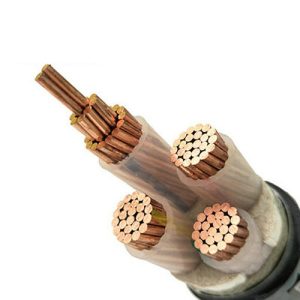A cable is a conductor that is covered with an insulation layer, a protective layer, a shield, etc., used to transmit electrical or signal current or signal voltage.
They can be divided by voltage into high-voltage cables, medium-voltage cables, and low voltage cables.
Low voltage cable lines in the low voltage ABC lines and low voltage overhead insulated lines, although the cost is higher, laying and maintenance are more difficult.
But because it has a reliable operation, has no pole, does not occupy the ground, is less affected by the outside world, and other characteristics, and in the low voltage distribution system is widely used.
Low Voltage Cable Structure
Low voltage cables structure consists of three parts: core, insulation layer, and protective layer.
The core is used to conduct current and is generally made of multiple strands of copper or aluminum strands stranded together.
Low voltage wires have single-core, double-core, three-core, four-core, and other types.
Double-core cables are used for single-phase lines, low voltage 3 wire and four-core cables are used for three-phase three-wire lines and three-phase four-wire lines respectively, and single-core cables can be applied to single-phase lines or three-phase lines as needed.
Commonly used low voltage cable core cross-sectional area of 10, 16, 25, 35, 50, 70, 95, 120, 150, 185, 240 mm, etc.

Insulation Layer
Insulation material in the cable with a specific function to withstand voltage.
The insulated cable is divided into two types: core insulation and tape insulation.
The insulation wrapped around the wire core is called core insulation.
The insulation of a multicore cable is called core insulation when the cores are combined and then covered with insulation.
With insulation and protective layer separated to form a reliable insulation to ground.
The insulation layer is usually made of oil-impregnated paper, plastic, rubber, etc.
1 Paper-insulated cable is impregnated cable paper for the insulation layer of the cable, generally known as paper-insulated cable.
According to the case of paper, impregnation can be divided into.
① Oil-impregnated paper-insulated cables.
② Dry insulation cable.
③ Non-drip cable.
2 Insulation layers made of thermoplastic extrusion cross-linked cable, generally known as plastic cable, are widely used.
Plastic cable can be divided into three kinds of PVC cable, polyethylene cable, and cross-linked polyethylene cable.
Natural butyl rubber, butyl rubber and ethylene propylene rubber, and other materials for the insulation layer of the cable is called rubber cable.
The voltage level of 1 kV of low voltage cable can be used paper insulated cable and plastic cable, more plastic cable. The voltage level of the 0.5 kV low voltage cable is more rubber cable.
Protective Layer
A layer or layers of metal or non-metallic materials cover the outside of the cable.
The protective layer is used to protect the insulation layer in the process of transportation, laying, and use, from external damage and moisture intrusion.
1 Paper Insulation Cable Protection Layer
The protective layer of paper-insulated cable is divided into two parts: the inner sheath and the outer sheath.
The inner sheath is directly extruded on the insulation layer, in addition to protecting the insulation from moisture.
There is a role in preventing the outflow of insulation oil and has a certain mechanical strength.
The inner sheath has the lead package, aluminum package, and polyvinyl chloride package three.
The outer sheath is to protect the inner sheath, to increase the ability of the cable to withstand mechanical external forces, and corrosion prevention.
The outer sheath includes the inner liner layer, the metal armor layer, and the outer layer.
The inner liner protects the metal sheath from being damaged by the metal armor layer and can be attached with anti-corrosion measures.
The metal armor layer can withstand a mechanical external force, and the outer layer can protect the armored metal from external corrosion.
2 Plastic Cable Protection Layers
Usually, polyvinyl chloride sheath is used outside the plastic insulation.
3 Rubber Cable Protection Layers
The rubber cable protection layer is divided into inner and outer sheaths.
The inner sheath has a PVC sheath, a neoprene sheath (non-combustible rubber), and lead package three.
The outer sheath is divided into three kinds of steel belt armor, rubber sheath, and plastic sheath.
Low Voltage Cable Selection
Cable selection mainly includes cable type selection and cable section selection.
Model Selection
Power cable model selection should be determined according to environmental conditions, laying methods, and special requirements of power equipment.
And other factors, and generally considered according to the following principles.
1 In the general environment and places suitable for the use of aluminum-core cable.
But in intense vibration and special buildings and places with special requirements, the copper-core cable should be used.
2 Buried cable, generally using an armored cable with an outer sheath.
In places where no mechanical damage is possible, plastic-sheathed cables and lead (aluminum) clad cables with an outer sheath can also be used.
3 In the chemical corrosion or stray current corrosion of the soil, should try not to use buried laying cable.
If you have to lay buried should be used when anti-corrosion type cable.
4 Laid in the tube or row of cable, generally using a plastic sheathed cable, can also use bare armored cable.
5 In the cable trench or cable tunnel laid in the cable, should not be used with a flammable or extended combustion outer sheath.
Generally use bare armored cable, plastic sheathed cable, and bare lead or bare aluminum clad cable.
6 When the cable is laid in places with a large height difference, it is appropriate to use plastic-insulated cables, non-drip cables, and dry-insulated cables.

Cross-Sectional Selection
The cross-sectional area of the cable should be selected according to the following four conditions.
① Select according to the heat generation condition.
② Choose according to the allowable voltage loss.
③ Choose according to the mechanical strength condition.
④ Choose according to the line protection (device) equipment with the choice.
Low Voltage Wire Types
Low Voltage ABC Cable
LV ABC cable, designed for overhead power lines and room entrance wires with a rated AC pressure of 1kv and below. It has less installation, maintenance, and operating costs, which can achieve greater economic loss and provide higher security and reliability.
Aluminum-Copper Conductor Low Power Cable
ZMS Cable supplies the most suitable aluminum-copper conductor low power cable and cable accessories for various engineering customizations.
We mainly provide complete supply services for distributors and suppliers all over the world.
Consulting services, purchasing services, transportation services, and after-sales services are included.
Low volt wire lines are mainly used in places where the reliability of the power supply is high, corrosive gases and flammable, explosive, etc. are not suitable for the erection of low voltage overhead lines or low voltage overhead insulated lines.
The above is a detailed introduction to low voltage cable, as a professional low voltage cable supplier, you are welcome to mail self-selection, we can customize low voltage cable according to your needs, and quality assurance.
We also have professional low voltage cable connectors and low voltage cable lighting for you to choose from.